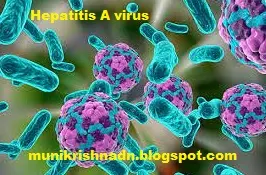HEPATITIS
This article describes about the following factors.
1. what is Hepatitis A?
2. signs and symptoms & complications of Hepatitis A?
3. Prevention and Pathogenesis of Hepatitis A virus ?
4. Treatment of Hepatitis A virus
Hepatitis A :-
Viral
hepatitis is the most common cause of hepatitis worldwide. Hepatitis is an
inflammation of the liver. It is lethal and can be progressed into fibrosis
(scarring), cirrhosis or liver cancer. However, the condition can be
self-limiting, hepatitis is caused by hepatitis virus. there are 5 different
types of hepatitis viruses, namely A, B,C,D and E. these 5 types are of
greatest concern, because it is the world-wide burden apart from this other
factor such as toxic substance ( e.g. alcohol, certain drugs ), and autoimmune
disease can also cause hepatitis.
More
particularly, types B and C lead to chronic disease in hundreds of millions of
people and, together, are the most common cause of liver cirrhosis and cancer.
Hepatitis
A and E are mainly transmitted by ingestion of contaminated food or water while
hepatitis B, C and D usually occur as a result of parenteral contact with
infected body fluids. Common modes of transmission for these viruses include
receipt of contaminated blood or blood products, invasive medical procedures
using contaminated equipment.
Acute
infection may occur with limited or no symptoms, or may include symptoms such
as jaundice (yellowing of the skin and eyes), dark urine, extreme fatigue,
nausea, vomiting and abdominal pain.
Hepatitis
A virus is very common in areas of the world with poor sanitation. The disease
is easily transmitted to others through blood, the oral-fecal route, anal sex,
and contaminated food and water. The virus travels through the bloodstream to
the liver where it infects hepatocytes, cells that form the liver’s main tissue
and make up most of its mass.
It
is simple, made up of only nucleic acid and proteins, but it is still able to
take over normal cell functions and convert them to make more viruses.
Complications: It
does not cause long-term liver damage. Sudden loss of liver function. Acute
liver failure is the complications of the infection.
HAV
differs from other hepatitis strains because it’s member of the picornavirus
family. Pin corna virus are small, non-enveloped, icosahedron-shaped virus. it is
a single stranded RNA virus with icosahedron 3-diamensional figure containing
20 faces resembling a soccer ball.
It
contains protein and nucleic acid. The protein of the nucleocapsid, called the
capsid.in some cases, the capsid helps the virus to enter inside the host and
protects the virus from the host immune system. The genome only has the genes
needed to shut down the host cell and make more viruses. These features of
hepatitis A Virus (HAV) are described below.
The
capsid of HAV is made up subunits called capsomeres as shown in figure.
Each capsomere is made up of five protomers. Each protomer of HAV is made of
three proteins; VPI, VP2, And VP3, which have a role in cell entry.
Genome: Figure
shown the genome of HAV is a single strand of RNA that is divided into three
sections. The genome of HAV is positive-sense, single stranded RNA, written as
ss (+) RNA. Because the virus is positive –sense RNA, it can be used as
m RNA and converted (translated) into protein upon entering the cell. The
genome has an at toms.
Pathogenesis: -
Source – food handler,
patient, contaminated water mode of transmission
Drinking contaminated
water
Eating raw shellfish
from water polluted with sewage
Being in close contact
with a person who’s infected –even if that person has no signs or symptoms
Sexual contact
It is not spread
through sneezing or coughing
Symptoms :
Fatigue
Sudden nausea and
vomiting
Abdominal pain or
discomfort, especially on the upper right side beneath your lower ribs ( by
your liver )
Clay- coloured bowel
movements
Loss of appetite
Low-grade fever
Dark urine joint pain
Yellowing of the skin
and the whites of yours eyes (jaundice)
Intense itching
Prevention: The hepatitis A vaccine
can be administered to prevent infection with the virus. The vaccine is
typically given in two shots. The first one is followed by a booster shot six
months later. The centers for disease control and prevention recommends a
hepatitis a vaccine foe following people:
All children at age 1,
or older children who didn’t receive the childhood vaccine laboratory by B
A Man who have sex with
men.
People with other risk
factors who work or travel in parts of the world where hepatitis A is common
people who use any type of illegal drugs, not just injected ones.
People who receive
treatment with clotting-factor concentrate people with chronic liver disease.
If you’re concerned about your risk of hepatitis A, ask your doctor if you
should be vaccinated.
Safety precautions when travelling: Peel
and wash all fresh fruits and vegetables Do not intake raw or uncooked meat and
fish. Avoid all beverage of unknown purity, with or without ice. If bottled
water is not available, boiled tap water can be used.
Practice good hygiene: Hands should be washed thoroughly
especially after using the toilet or changing a diaper and before
preparing food or eating.








0 Comments